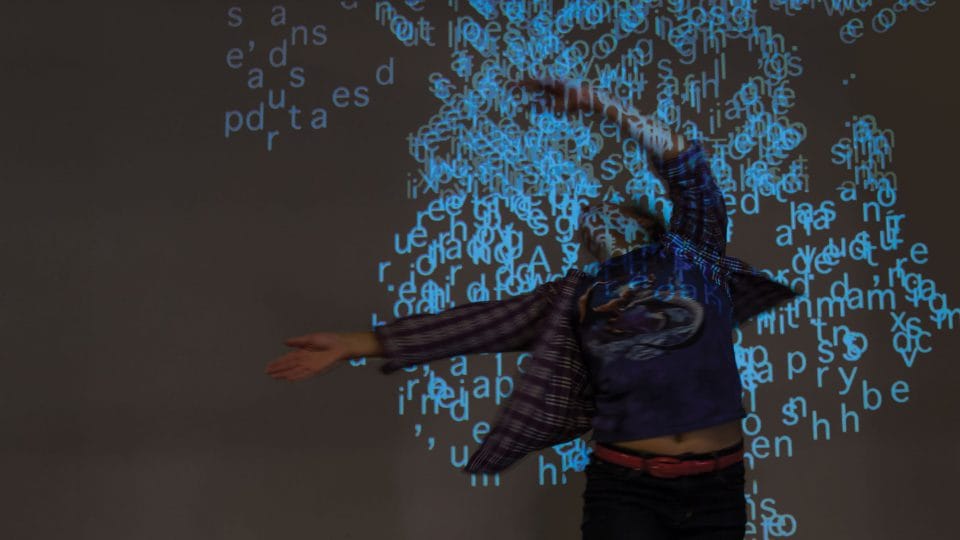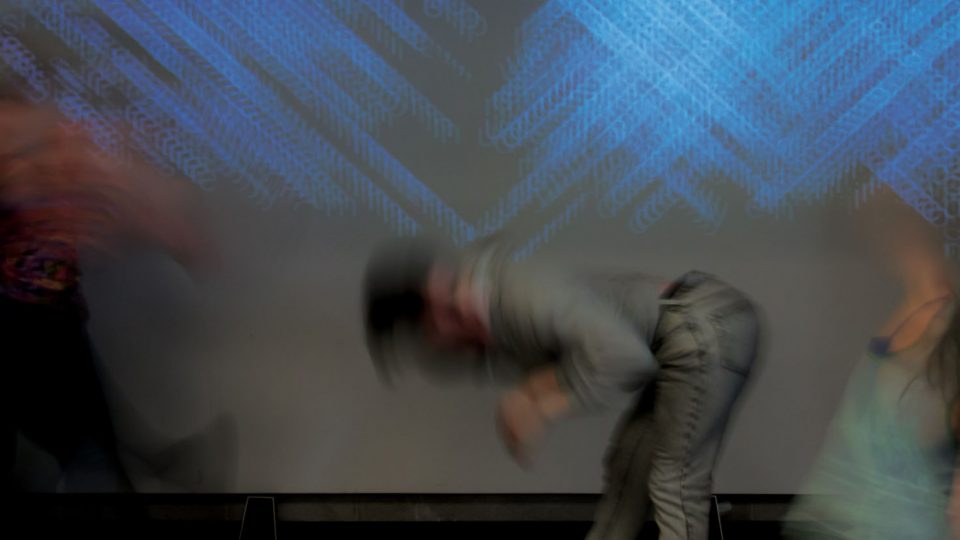 Body Language (2000 – 2013) is a suite of four interactive works that has us encounter some of the complex relationships between materiality and text. Each piece stages the experience and practice of bodies and language in a different way, enabling in-depth explorations of how they are always implicated across one another. elicit invites viewers to perform the continuity between text and the body; enter effectively asks its participants to investigate how words and activity are inherently entwined; stuttering provokes its performers into exploring the labor and intimacy of embodied listening and communication; and scripted asks us to remember how the activities of writing, the shape and sound of language, are forever a part of the physical world.
Body Language (2000 – 2013) is a suite of four interactive works that has us encounter some of the complex relationships between materiality and text. Each piece stages the experience and practice of bodies and language in a different way, enabling in-depth explorations of how they are always implicated across one another. elicit invites viewers to perform the continuity between text and the body; enter effectively asks its participants to investigate how words and activity are inherently entwined; stuttering provokes its performers into exploring the labor and intimacy of embodied listening and communication; and scripted asks us to remember how the activities of writing, the shape and sound of language, are forever a part of the physical world.
video documentation
For elicit, a poem in the computer’s memory is birthed, character by character, from every small or sweeping gesture participants make in front of a projection screen. It elicits fluidly animated text as continuously shifting animations, varying characters and colors that float out from and around our movements, which in turn elicit fluid performances from us.
 With enter, performers use their bodies to grab animated words that constantly run away from them on a large projection screen. Touch any one, and it stops, turns red, and recites spoken word in the space. The piece is inspired by JL Austin’s explanation of performative utterances, where statements such ‘I do’ (at a wedding), ‘I declare’ (as in war) or ‘I knight thee,’ make a change in the real world. Here participants literally use their bodies to chase after words, turn on a phrase, or reach (for) the end of a sentence. Their rapid and jerky styles amplify how saying and doing, affection and reflection, are often one and the same.
With enter, performers use their bodies to grab animated words that constantly run away from them on a large projection screen. Touch any one, and it stops, turns red, and recites spoken word in the space. The piece is inspired by JL Austin’s explanation of performative utterances, where statements such ‘I do’ (at a wedding), ‘I declare’ (as in war) or ‘I knight thee,’ make a change in the real world. Here participants literally use their bodies to chase after words, turn on a phrase, or reach (for) the end of a sentence. Their rapid and jerky styles amplify how saying and doing, affection and reflection, are often one and the same.
 stuttering – developed and shown in dialogue with people who stutter – provokes its viewers into exploring the labor and intimacy of embodied communication, compelling them to stutter with their bodies. Here an invisible and asymmetrical projection grid is saturated with trigger points, each activating animated text and spoken word as our bodies cross its path. The saturation of these ‘virtual buttons’ creates an inverse relationship: move quickly, and the piece will itself stutter in a barrage of audiovisual verbiage; move carefully, even cautiously – stutter with your body – and both meaning and bodies emerge.
stuttering – developed and shown in dialogue with people who stutter – provokes its viewers into exploring the labor and intimacy of embodied communication, compelling them to stutter with their bodies. Here an invisible and asymmetrical projection grid is saturated with trigger points, each activating animated text and spoken word as our bodies cross its path. The saturation of these ‘virtual buttons’ creates an inverse relationship: move quickly, and the piece will itself stutter in a barrage of audiovisual verbiage; move carefully, even cautiously – stutter with your body – and both meaning and bodies emerge.
 And for scripted, we must imagine that the ceiling is a piece of paper, and our heads are made of charcoal. It uses 3D-tracking data to follow participants’ moving heads – forward and backward, right and left, in exaggerated and fully embodied gestures – and draws slowly fading, charcoal-like lines of these actions on screen. If and when any of the shapes we create resemble a character from the English alphabet (using the Palm Pilot “graffiti“ gestures), that letter will be temporarily overlaid in the projection in the standard Times font, accompanied by a John Cage-like oral recitation (“Aaaaah,” “Buh,” “Kkkkk,” and so on). Some letters are much more difficult to scribe than others, and many of the more complex characters contain echoes of simpler ones, in how we must move – making writing both difficult, and sometimes accidental. The piece is less about accomplishing specific gestures, and more about encountering and rehearsing textual moving-thinking-feeling at large.
And for scripted, we must imagine that the ceiling is a piece of paper, and our heads are made of charcoal. It uses 3D-tracking data to follow participants’ moving heads – forward and backward, right and left, in exaggerated and fully embodied gestures – and draws slowly fading, charcoal-like lines of these actions on screen. If and when any of the shapes we create resemble a character from the English alphabet (using the Palm Pilot “graffiti“ gestures), that letter will be temporarily overlaid in the projection in the standard Times font, accompanied by a John Cage-like oral recitation (“Aaaaah,” “Buh,” “Kkkkk,” and so on). Some letters are much more difficult to scribe than others, and many of the more complex characters contain echoes of simpler ones, in how we must move – making writing both difficult, and sometimes accidental. The piece is less about accomplishing specific gestures, and more about encountering and rehearsing textual moving-thinking-feeling at large.
 Body Language, as a collection of works, invites us to explore the reaches and limits of bodies and language, together, in order to better understand how they are formed, together. It poses a challenge to how bodies are mediated and re-mediated in contemporary culture by putting embodiment and signification on the same plane of existence. And finally, it implicitly asks what is at stake in how we perform our bodies and our media. It is so easy to forget the body – as continuously embodied – in our theorizations of ‘the body.’ Jean-Luc Nancy reminds us that all language and writing require, first and foremost, bodies to produce them. And bodies, in turn, “take place neither in discourse nor matter” alone (Corpus, p 18). Each of the four electronic installations in the Body Language exhibition uses the moving-thinking-feeling body as an interface with language and technology. They give us a number of different ways to investigate and perform precisely what bodies, as “an expression of meaning” (Sorial, p 224), can be.
Body Language, as a collection of works, invites us to explore the reaches and limits of bodies and language, together, in order to better understand how they are formed, together. It poses a challenge to how bodies are mediated and re-mediated in contemporary culture by putting embodiment and signification on the same plane of existence. And finally, it implicitly asks what is at stake in how we perform our bodies and our media. It is so easy to forget the body – as continuously embodied – in our theorizations of ‘the body.’ Jean-Luc Nancy reminds us that all language and writing require, first and foremost, bodies to produce them. And bodies, in turn, “take place neither in discourse nor matter” alone (Corpus, p 18). Each of the four electronic installations in the Body Language exhibition uses the moving-thinking-feeling body as an interface with language and technology. They give us a number of different ways to investigate and perform precisely what bodies, as “an expression of meaning” (Sorial, p 224), can be.
Also see the Body Language catalog, with essay by Charlie Gere
Body Language was first exhibited as a full suite of works at the Wits Art Museum (WAM) in Johannesburg, as half of the duo exhibition Meaning Motion with South African artist Tegan Bristow, June – August 2013. It was produced with major support from the UWM Research Growth Initiative, and the exhibition was supported in part by funds provided by the UWM Graduate School. Body Language (made with openFrameworks) production team: Nathaniel Stern, Neetu Katiyar, Andrew McConville and Wyatt Tinder.
Related texts/press:



















































